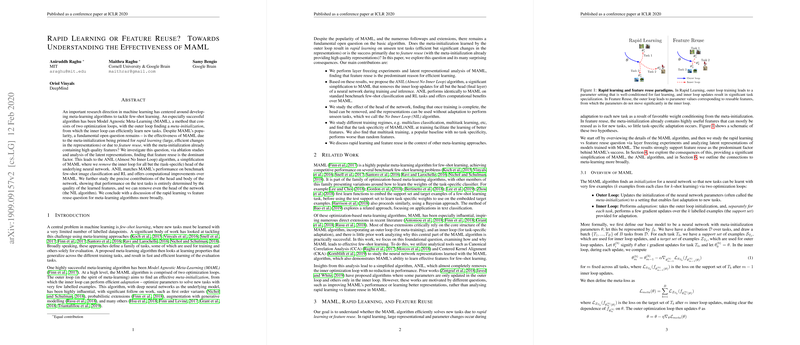Overview of Rapid Learning or Feature Reuse? Towards Understanding the Effectiveness of MAML
The paper "Rapid Learning or Feature Reuse? Towards Understanding the Effectiveness of MAML" provides a thorough examination of the Model Agnostic Meta-Learning (MAML) algorithm. This paper investigates whether MAML's effectiveness is primarily due to rapid learning, manifested as significant representational changes during adaptation, or feature reuse, where the meta-initialization already encodes high-quality features that are easily adaptable to new tasks.
Key Contributions
- Feature Reuse Analysis: The authors conduct ablation studies and latent representational analyses to understand the workings of MAML. Results reveal that feature reuse, rather than rapid learning, is the dominant factor, with most layers of the model requiring minimal adaptation for new tasks.
- ANIL Algorithm: Building on the insights of feature reuse, the paper introduces the ANIL (Almost No Inner Loop) algorithm. ANIL simplifies MAML by eliminating the inner loop updates for all layers except the task-specific head. Despite this significant simplification, ANIL maintains performance parity with MAML on benchmark few-shot image classification and reinforcement learning tasks while offering computational benefits.
- Network Contribution Analysis: Further investigations show that the task-specific head can actually be removed, leading to the NIL (No Inner Loop) algorithm. This variant demonstrates that high-quality features learned during training are sufficient for task performance without any task-specific adaptations at test time.
- Training Regimes: The paper explores the implications of various training regimes, highlighting that MAML’s task specificity during training is crucial for learning effective features, as opposed to multitask or random feature baselines, which perform considerably worse.
Implications and Future Directions
The findings have substantial implications for the development and understanding of meta-learning algorithms. By emphasizing the role of feature reuse, the paper suggests that the primary focus should be on the quality of learned features rather than task-specific adaptations during inference. This insight could direct future research towards optimizing the initial feature learning process and exploring new meta-learning techniques that build on strong feature representations.
The development of the ANIL and NIL algorithms demonstrates practical benefits in terms of computational efficiency, which is crucial for scaling meta-learning models to larger datasets and more complex tasks. Future work might explore the potential of these simplified approaches across a broader range of applications and datasets.
Conclusion
The paper successfully challenges the prevailing assumption of rapid learning in MAML, offering a nuanced understanding of its effectiveness through the lens of feature reuse. By dissecting the contributions of different network components and introducing computationally efficient variants, the paper lays a foundation for further exploration of meta-learning paradigms. This work not only refines the theoretical understanding of MAML but also provides practical insights that could inform the design of future algorithms in the field.
